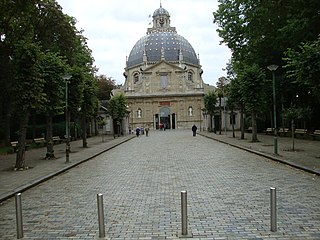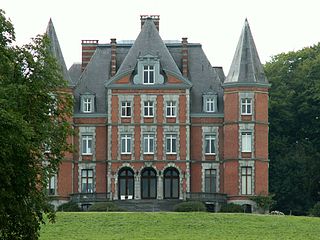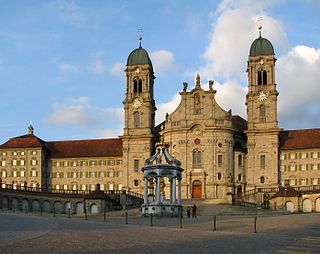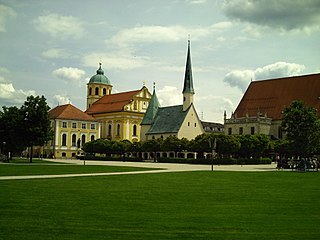
Scherpenheuvel-Zichem is a city and municipality located in the province of Flemish Brabant, Flemish Region, Belgium, encompassing the towns of Averbode, Messelbroek, Okselaar, Scherpenheuvel, Schoonderbuken, Keiberg, Kaggevinne, Testelt and Zichem. On January 1, 2020, Scherpenheuvel-Zichem had a total population of 23,135. The total area is 50.50km2 which gives a population density of 458.1 inhabitants per km2.

Ittre is a municipality of Wallonia located in the Belgian province of Walloon Brabant. Since the Fusion of the Belgian municipalities in 1977, the municipality is composed of three districts: Haut-Ittre, Ittre and Virginal-Samme.

Walsingham is a civil parish in North Norfolk, England, famous for its religious shrines in honour of Mary, mother of Jesus. It also contains the ruins of two medieval monastic houses. Walsingham is 27 miles (43 km) northwest of Norwich.

Einsiedeln Abbey is a Roman Catholic monastery administered by the Benedictine Order in the village of Einsiedeln, Switzerland. The abbey is dedicated to Our Lady of the Hermits, in recognition of Meinrad of Einsiedeln, a hermit Catholic saint. The monastery is not under the jurisdiction of a diocese or a bishop because it is a territorial abbey.

Pittenweem Priory was an Augustinian priory located in the village of Pittenweem, Fife, Scotland.

Charbel Makhlouf, O.L.M., born Youssef Antoun Makhlouf and venerated as Saint Charbel, was a Maronite monk and priest from Lebanon. During his life, he obtained a wide reputation for holiness, and for his ability to unite Christians and Muslims.

Altötting is a town in Bavaria, capital of the district Altötting of Germany. For 500 years it has been the scene of religious pilgrimages by Catholics in honor of Mary, including a visit by Pope John Paul II in 1980 and one by Pope Benedict XVI in 2006.

Leonard of Noblac, is a Frankish saint closely associated with the town and abbey of Saint-Léonard-de-Noblat, in Haute-Vienne, in the Limousin region of France. He was converted to Christianity along with the king, at Christmas 496. Leonard became a hermit in the forest of Limousin, where he gathered a number of followers. Leonard or Lienard became one of the most venerated saints of the late Middle Ages. His intercession was credited with miracles for the release of prisoners, women in labour and the diseases of cattle.

Canons regular are priests who live in community under a rule and are generally organised into religious orders, differing from both secular canons and other forms of religious life, such as clerics regular, designated by a partly similar terminology.

The Archdiocese of Cambrai is a Latin Church ecclesiastical jurisdiction or archdiocese of the Catholic Church in France, comprising the arrondissements of Avesnes-sur-Helpe, Cambrai, Douai, and Valenciennes within the département of Nord, in the region of Nord-Pas-de-Calais. The current archbishop is Vincent Dollmann, appointed in August 2018. Since 2008 the archdiocese has been a suffragan of the Archdiocese of Lille.

Our Lady of Walsingham is a title of Mary, mother of Jesus venerated by Catholics, Western Rite Orthodox Christians, and some Anglicans associated with the Marian apparitions to Richeldis de Faverches, a pious English noblewoman, in 1061 in the village of Walsingham in Norfolk, England. Lady Richeldis had a structure built named "The Holy House" in Walsingham which later became a shrine and place of pilgrimage.

Floreffe Abbey is a former Premonstratensian monastery, the second of the order to be founded, situated in Wallonia on the Sambre at Floreffe, about 11 km southwest of Namur, Belgium.

Walsingham Priory was a monastery of Augustinian Canons regular in Walsingham, Norfolk, England seized by the crown at the Dissolution of the Monasteries under King Henry VIII.
St Andrews Cathedral Priory was a priory of Augustinian canons in St Andrews, Fife, Scotland. It was one of the great religious houses in Scotland, and instrumental in the founding of the University of St Andrews.

Frigolet Abbey — The Pontifical Shrine of Our Lady of Good Remedy and Saint Joseph is a grand Premonstratensian monastery complex in southern France. It is located in the territorial commune of Tarascon, in the region of the Montagnette, the parishes of which are served by the canons of the monastery. It was originally associated with the Order of Saint Benedict.

The Basilica of Our Lady of Tongre is a Roman Catholic parish church and minor basilica in Tongre-Notre-Dame, Chièvres, Belgium. The shrine is small, yet rich in historical significance.

Monks Kirby Priory was a Benedictine priory established in 1077 in Monks Kirby, Warwickshire, England. The priory was suppressed in 1415 when its estates and revenues were given to the Carthusian priory of Axholme in Lincolnshire, in whose possession they continued until the Reformation. Remains of the priory form part of Monks Kirby village church today.

The Anglican Shrine of Our Lady of Walsingham is a Church of England shrine church built in 1938 in Walsingham, Norfolk, England. Walsingham is the site of the reputed Marian apparitions to Richeldis de Faverches in 1061. The Virgin Mary is therefore venerated at the site with the title of Our Lady of Walsingham.

Our Lady of Consolation or Mary, Consoler of the Afflicted is a Roman Catholic title of the Blessed Virgin Mary. It dates back to the second century and is one of her earliest Marian titles of honor. The title Comforter of the afflicted is also used as an invocation in the Litany of Loreto.



















